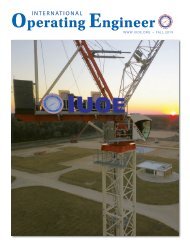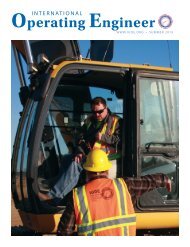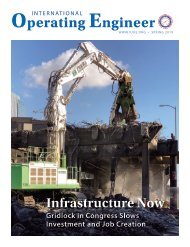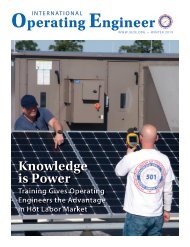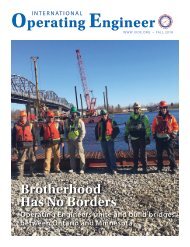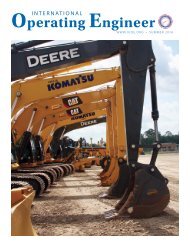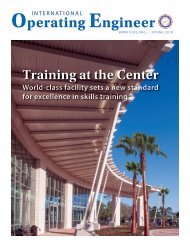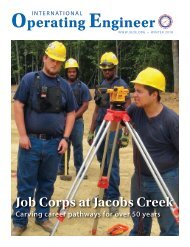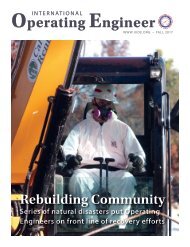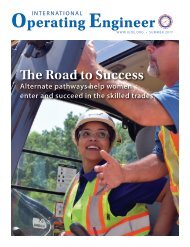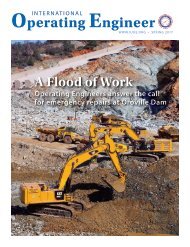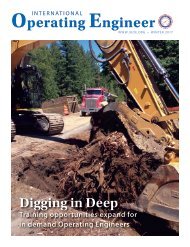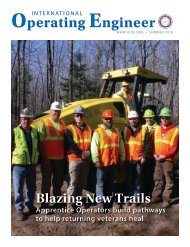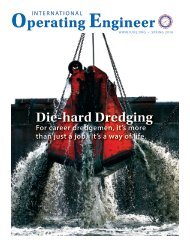125 Years Strong – An IUOE History
Celebrating the 125th Anniversary of the founding of the International Union of Operating Engineers
Celebrating the 125th Anniversary of the founding of the International Union of Operating Engineers
You also want an ePaper? Increase the reach of your titles
YUMPU automatically turns print PDFs into web optimized ePapers that Google loves.
INTERNATIONAL UNION OF OPERATING ENGINEERS<br />
Members of Ladies’ Auxiliary No. 6, which was affiliated with International Union of Steam and Operating Engineers Local No. 68 of<br />
Newark, New Jersey, pose during their Christmas party on December 27, 1917. Ladies’ auxiliaries were often operated by the wives and<br />
girlfriends of I.U.O.E. members to support the social, charitable and community functions of their respective locals into the early 1970s.<br />
President Comerford substantiated <strong>–</strong> and<br />
conveyed through correspondence and official<br />
reports <strong>–</strong> any positive outlook of the I.U.S.E in<br />
July 1912 when he conducted a cross-country<br />
journey and visited with multiple locals. In<br />
particular, the president noted that in Portland<br />
and Spokane, Washington, he found “a band<br />
of brave fellows in our organization there, and<br />
with the new young blood which has been<br />
imparted to the life of the locals, the future looks<br />
safe.” He also eagerly announced that union<br />
engineers working on a five-story building<br />
under construction in Seattle were being paid<br />
$5 per day while non-union engineers in the<br />
vicinity were receiving only $4.<br />
Then during the union’s annual convention<br />
beginning September 9, 1912, in St. Paul,<br />
Minnesota, after the general membership<br />
had earlier voted by referendum in favor of<br />
instituting a long-discussed Death Benefit<br />
Fund, a committee submitted a list of<br />
insurance plans through which the fund could<br />
be established. In September the following year,<br />
the union’s General Executive Board presented<br />
four options to the membership, from which,<br />
as a whole, it would select a provider for the<br />
new benefit.<br />
Delegates to the convention also adopted<br />
amendments to the constitution that would<br />
allow the union to better sanction the admission<br />
of apprentice engineers into its membership,<br />
thereby overhauling, as an essay in the January<br />
1913 International Steam Engineer described<br />
it, “the most haphazard way in the past that<br />
our general body has been able to bestow any<br />
consideration at all on the channels through<br />
which men have been admitted into the<br />
practice of the engineers’ calling.” With the new<br />
statutes, the union would be able to exercise<br />
more control over applicants for membership<br />
in regard to their training and experience,<br />
about which the article proclaimed, “This is<br />
one of the foremost requirements to protecting<br />
our organization and promoting its usefulness<br />
to its membership as well as to the craft.”<br />
Reflecting on all of the actions and<br />
accomplishments of the 1912 convention,<br />
the essay lauded the entirety of the engineers’<br />
union organization for making those vital<br />
strides possible:<br />
“They are not the result of last<br />
year’s work or the work of any<br />
given year. They are the necessary<br />
fruits of the work which has been<br />
done all throughout the years of the<br />
existence of the I.U.S.E., and every<br />
member in good standing of the<br />
organization has borne his part in<br />
producing them just as surely, if not<br />
just as effectively, as has the highest<br />
officer or the most influential<br />
member of our body.”<br />
The steam-engineering industry itself was<br />
also progressing, with internal-combustion<br />
engines powered by gasoline and diesel fuel<br />
already beginning to dominate the trades.<br />
Steam shovels, for instance, evolved in 1911<br />
into full-swing power shovels that were lighter<br />
and more versatile and more mobile, and the<br />
gas-powered shovel was becoming the mainstay<br />
for heavy-equipment operators.<br />
On his cross-country trip in the summer of<br />
1912, President Comerford noticed a large<br />
number of portable steam-powered hoisting<br />
engines in a scrap heap in San Francisco,<br />
having been replaced by electric motors and<br />
gasoline engines. He duly noted, “Their days<br />
of usefulness had passed; their places had<br />
been taken by more modern-appliances. …<br />
This is something we cannot afford to pass<br />
by thoughtlessly.”<br />
With the marked increase in the use of the<br />
internal-combustion engines and electric<br />
motors, hydraulic machinery and refrigerating<br />
systems, as well as steam boilers and engines,<br />
the types of work performed by the union’s<br />
growing membership were changing as<br />
members’ roles became more diverse and<br />
more construction workers came into the<br />
organization. Accordingly, during its 1912<br />
convention, the union amended its name to the<br />
International Union of Steam and Operating<br />
Engineers (I.U.S.O.E.) <strong>–</strong> the “operating”<br />
added to the title as a catchall for operators of<br />
non-steam-powered machinery.<br />
According to The Economic <strong>History</strong> of a<br />
Trade Union, the union also championed an<br />
immediate name change after an expelled<br />
former member of a New Jersey local organized<br />
and incorporated a group that he called the<br />
“International Union of Steam Engineers.” As<br />
the union had never registered its previous title<br />
of the same name, the book points out, “it took<br />
immediate steps to protect the new one.”<br />
Transformed by Technology<br />
The conversion of the I.U.S.O.E.<br />
from a steam engineers’ union to an<br />
organization of operators of gasoline-,<br />
diesel- and electrically powered machines<br />
would continue into the late 1920s. Along<br />
with that, great strides were being made on<br />
the local level in obtaining better conditions<br />
for members; for example, in 1913, Boston’s<br />
Local No. 16 secured a contract with breweries<br />
that was described as a “model” agreement that<br />
provided $35 weekly pay for chief engineers<br />
and $28 for others, the eight-hour workday<br />
and arbitration of grievances between the<br />
employers and employees.<br />
Correspondingly, in the latter part of 1913,<br />
engineers around the nation were beginning<br />
to learn about the emerging technology of<br />
mechanical refrigeration, as thousands of<br />
butcher shops, creameries, ice-cream factories<br />
and other manufacturers had already installed<br />
refrigerating machineries and abandoned<br />
the use of ice for refrigeration. What’s more,<br />
small refrigerating machines for household<br />
use were coming of age, as was the cooling<br />
of residences, office buildings and theaters,<br />
making it incumbent upon engineers to learn<br />
the mechanics of the new development.<br />
I.U.S.O.E. members then gained their<br />
first-ever international insurance plan at the<br />
beginning of 1914 when, as a result of the<br />
referendum in 1912, the union established a<br />
Death Benefit Fund. The group insurance was<br />
arranged with the Metropolitan Life Insurance<br />
LABOR OMNIA VINCIT<br />
WORK CONQUERS ALL



